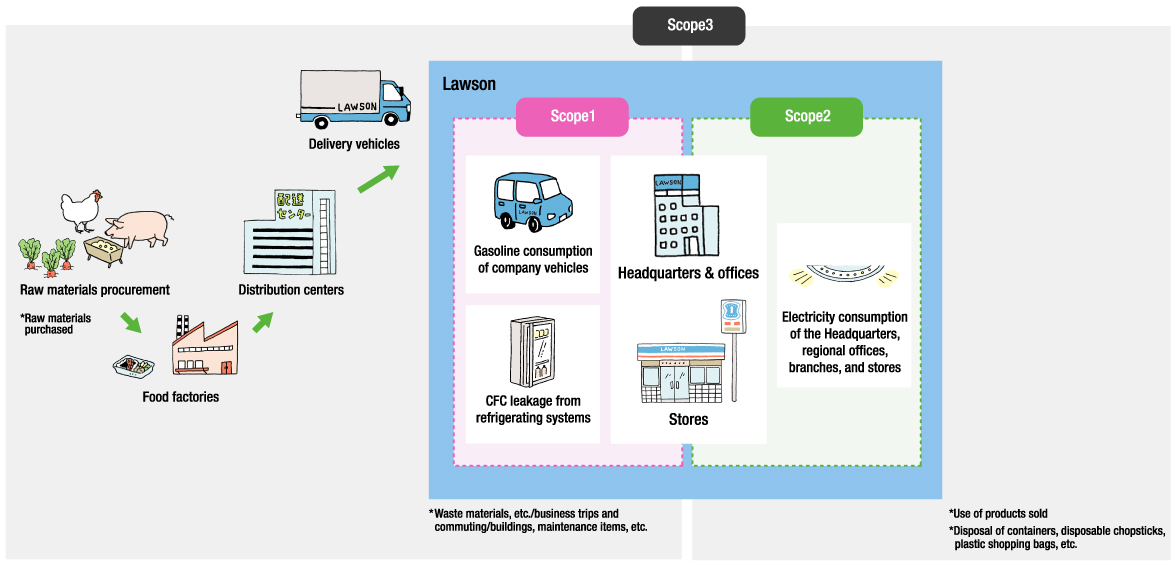SUSTAINABILITY Supply Chain
Environmental Preservation Activities throughout the Supply Chain
Reducing CO2 Emissions throughout the Supply Chain
Our environmental impact is due not only to our own, direct operations, but to all stages in the supply chain, from raw material procurement to product manufacturing, logistics, sales, disposal, and recycling. We strive to understand our environmental impact at each stage, review steps needed for reduction, and take action to reduce energy consumption, resource use, and waste.
We are particularly focused on understanding the CO2 emissions of our supply chain, and every year we ask our business partners, including factories that manufacture rice products and distribution centers, to cooperate in a questionnaire to understand their CO2 emissions. Going forward, we will examine items that need to be addressed and promote the reduction of CO2 emissions by verifying changes over time and the effects of our reduction measures.
Material Flow in Our Supply Chain
- Scope1
- Direct CO2 emissions from sources such as fuels used by the company.
(In the case of Lawson, this applies to the use of gasoline in company cars and CFC leakage from refrigerating systems in stores.)
Since FY 2023, we have added the amount of CFC leakage from refrigerating systems at stores.
- Scope2
- CO2 emissions from the use of purchased electricity (CO2 emissions from electricity used by offices and stores)
Scope: franchise stores and directly managed stores of LAWSON, NATURAL LAWSON, and LAWSON STORE100
- Scope3
- CO2 emissions arising from company operations other than scopes 1 and 2.

CO2 emissions from our supply chain in fiscal 2023
(Target period: from April 2023 to March 2024)*
| Categories | Details | CO2 emissions (Thousand tons CO2) |
|
|---|---|---|---|
| Scope1 (Direct emissions) | Gasoline consumption of company vehicles and CFC leakage from refrigerating systems | 50.3 | |
| Scope2 (Indirect emissions) | Electricity consumption of the Headquarters, regional offices, branches, and stores | 988.8 | |
| Scope3 (Other indirect emissions) | Categories 1 | Raw materials purchased (Private and national brand products, plastic shopping bags, etc.) |
4,405.8 |
| Categories 2 | Buildings, furniture and fixtures etc., and information system hardware |
123.4 | |
| Categories 3 | Electricity consumption associated with procurement of electric power | 150.6 | |
| Categories 4 | Energy consumption of the distribution centers | 139.7 | |
| Categories 5 | In-store waste, and industrial waste due to store closures and remodeling |
23.7 | |
| Categories 6 | Business trips by Lawson Headquarters employees | 0.8 | |
| Categories 7 | Commutes by Lawson Headquarters employees | 2.0 | |
| Categories 11 | Use of products sold | 39.6 | |
| Categories 12 | Disposal of containers, chopsticks, and plastic shopping bags | 39.4 | |
| Total | 5,964.1 | ||
* Calculations are based on the Basic Guidelines for Calculating Greenhouse Gas Emissions Throughout the Supply Chain Ver. 2.6 and the emissions intensity database Ver. 3.4 for calculating greenhouse gas emissions of organizations throughout the supply chain. It does not cover Lawson’s entire supply chain. Scope 2 includes electricity consumption by franchise stores that belong to Category 14 of Scope 3.
Third-party validation has been performed on the record for fiscal 2023 by the Japan Management Association.
